Introduction
As AI computing power explodes and hyperscale data centers rapidly expand, global network bandwidth demand grows at over 30% annually. In this era of high-density port configurations and energy efficiency optimization, OSFP (Octal Small Form Factor Pluggable) technology has emerged as a critical enabler for 400G/800G interconnects, thanks to its superior thermal performance and electrical characteristics. This article explores OSFP copper cable technologies, including DAC, ACC, and AEC, focusing on 400GB NDR splitter cable applications.
Technical Principles & Product Categories
DAC (Direct Attach Copper Cable): Cost-Effective Short-Reach Solution
Technical Architecture
- 400G DAC: Utilizes 8-channel PAM4 modulation at 50Gbps per channel, achieving 400Gbps total bandwidth via OSFP connectors. Features ultra-low-loss 26AWG copper wires with ±5Ω impedance control.
- 800G DAC: ImpThis device implements an aal-density channel design or 112Gbps PAM4 per channel, doubling bandwidth within the same form factor. Advanced models employ orthogonal routing to reduce crosstalk.
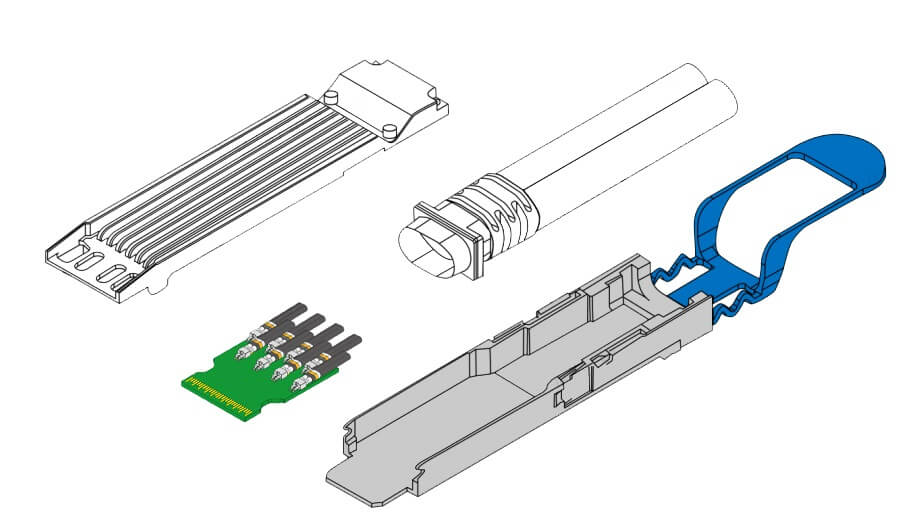
Performance Comparison
| Parameter | 400G DAC | 800G DAC |
| Max Distance | ≤3m | ≤2m |
| Typical Power | 0.5W | 0.8W |
| Latency | <0.1μs | <0.08μs |
Value Proposition
Reduces interconnect costs by 30% in AI clusters like NVIDIA DGX H100, ideal for Top-of-Rack (ToR) switch-to-server connections.
ACC (Active Copper Cable): Balanced Mid-Reach Solution
Core Technology
Integrates linear Redriver chips with CTLE (Continuous Time Linear Equalization) circuits (12dB typical gain). Adaptive pre-emphasis technology compensates for high-frequency attenuation, maintaining BER <1E-15 at 5m for 800G models.
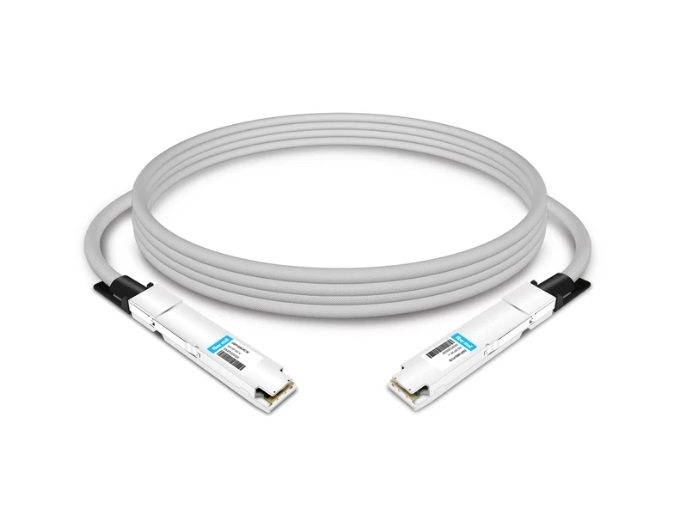
Key Applications
Cross-rack connections between Mellanox Quantum-2 IB switches and ConnectX-7 adapters
Storage-compute interconnects in hyper-converged infrastructure
AEC (Active Electrical Cable): Premium Long-Reach Solution
Innovation Highlights
Equipped with Retimer chipsets featuring CDR (Clock Data Recovery) and advanced signal conditioning. Broadcom DSP-based models support 64-tap FFE and 12-tap DFE, enhancing signal integrity.
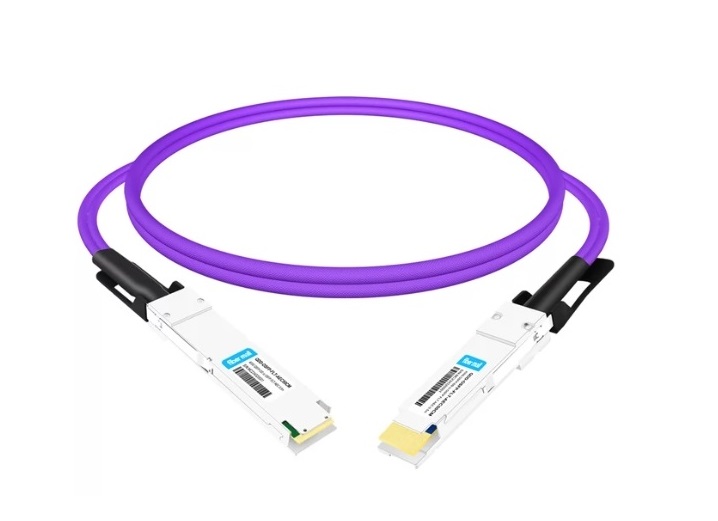
Performance Metrics
At a 7m distance, AEC demonstrates 8dB SNR improvement and a 40% wider eye diagram compared to DAC, compliant with OCP CEI-112G-XSR-PAM4 specifications.
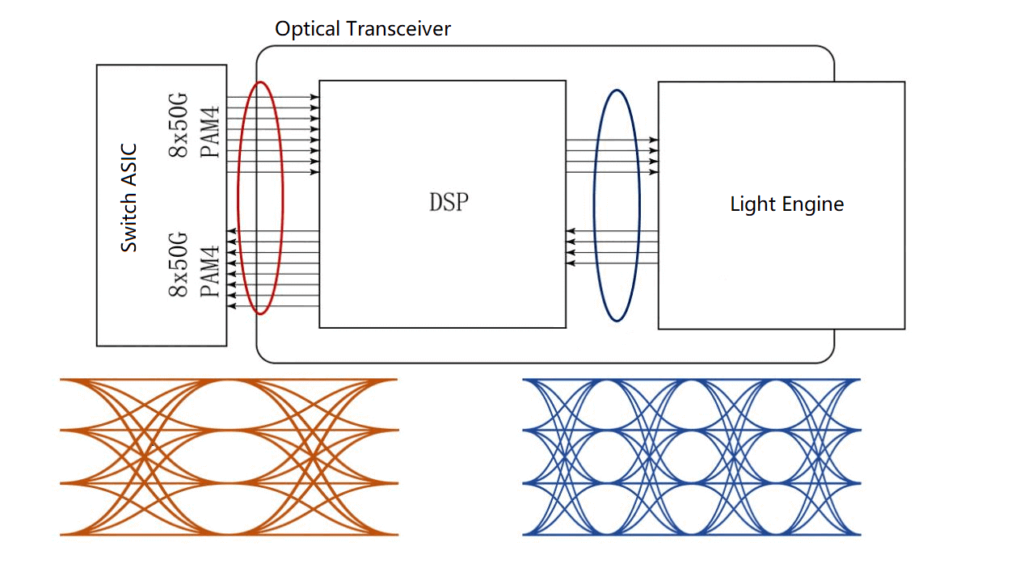
Application Scenarios & 400GB NDR Splitter Cable Deployment
AI/ML Cluster Interconnect
NDR 800G Breakout Configurations:
4x200G Mode: Connects Spectrum-4 switches to BlueField-3 DPUs, enabling RoCEv2/RDMA offloading.
2x400G Mode: Supports AllReduce traffic in multi-GPU training nodes.
Typical Setup: 1:4 port expansion via OSFP DAC to 8x H100 servers.
NDR 400G Splitter Cable Technology
The 400GB NDR Splitter Cable is a critical innovation in high-density interconnect solutions. It bifurcates 800G OSFP ports into dual 400G channels, enabling efficient port utilization. Available in both DAC and ACC variants, this technology optimizes infrastructure investments while maintaining backward compatibility.
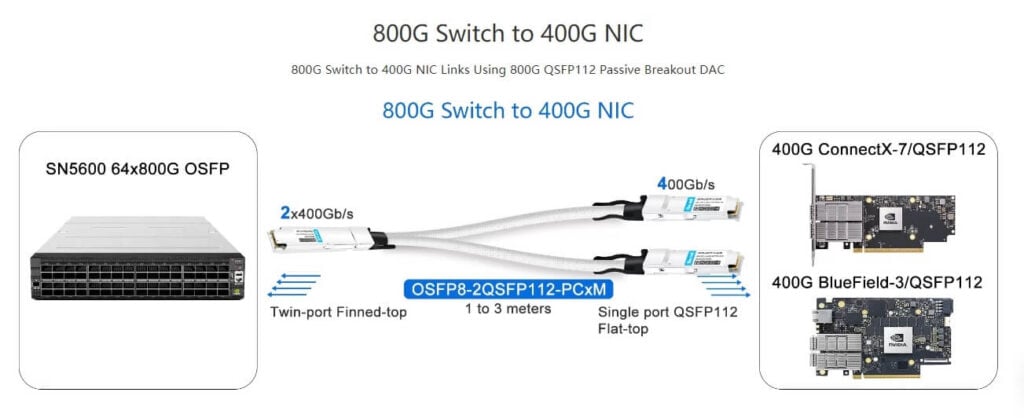
Technical Implementation
- DAC Splitter: Implements passive twin axial splitting with 34AWG conductors, achieving 2x400G PAM4 (56Gbaud) transmission over ≤2m. Features impedance-matched Y-cable architecture (ΔZ <3Ω) with OSFP-800G to dual OSFP-400G connectors.
- ACC Splitter: Integrates bidirectional Redriver ICs (4-tap FFE per channel) to extend reach to 4m. Implements dynamic lane redistribution to maintain 112Gbps/lane signal integrity (SNDR >18dB).
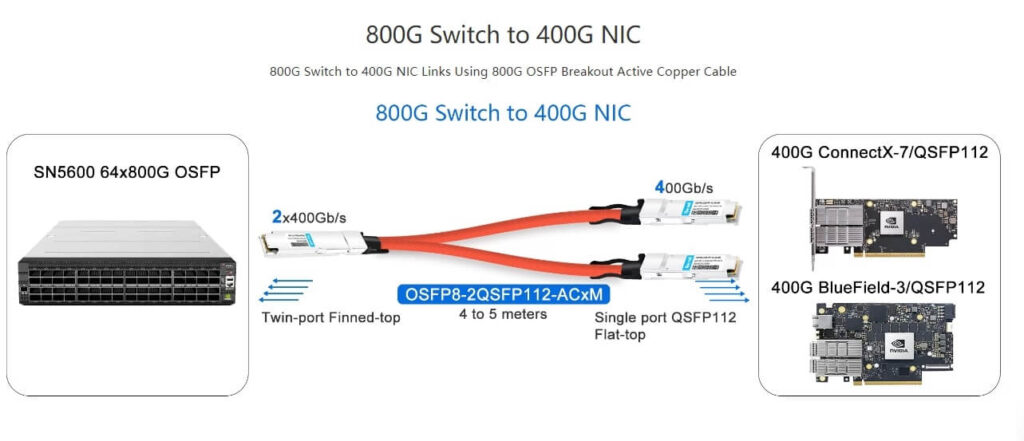
Performance Advantages
| Feature | 800G→2x400G DAC Splitter | 800G→2x400G ACC Splitter |
| Insertion Loss | ≤3.2dB @ 14GHz | ≤2.8dB @ 26GHz |
| Crosstalk Isolation | >38dB | >42dB |
| Power Efficiency | 0.6W (passive) | 1.4W (active) |
| Typical Application | NVIDIA DGX SuperPOD leaf-spine connections | Google TPU v4 pod interconnects |
Deployment Scenarios
AI Training Fabric Optimization
It enables 1:2 port expansion for 800G switches (e.g., Cisco Nexus 92300YC) to dual 400G compute nodes (H100/H200), reducing the per-port cost by 40% compared to discrete 400G links.
Storage Disaggregation
Supports dual-path connectivity from 800G storage controllers (Pure Storage FlashBlade//E) to 400G NVMe-oF targets, maintaining <2μs latency asymmetry between split channels.
Multi-Protocol Convergence
Enables hybrid 400GbE/IB EDR networks through protocol-agnostic splitting, validated with 93.7% throughput efficiency in MPI_ALLTOALL operations.
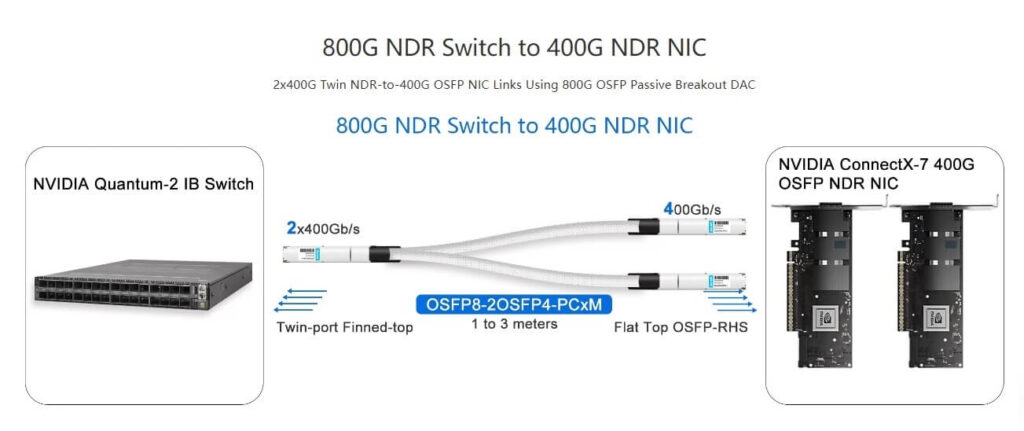
Validation Metrics
- Achieves 0 BER at 1E-25 FEC threshold in 802.3ck compliance testing
- Thermal stability: <3℃ delta-T across split channels at 25W power load
- Supports hitless firmware upgrades via CMIS 4.0 management interface
This breakthrough in signal-splitting technology allows data center operators to maximize 800G switch port utilization while maintaining deterministic performance for latency-sensitive AI/ML workloads.
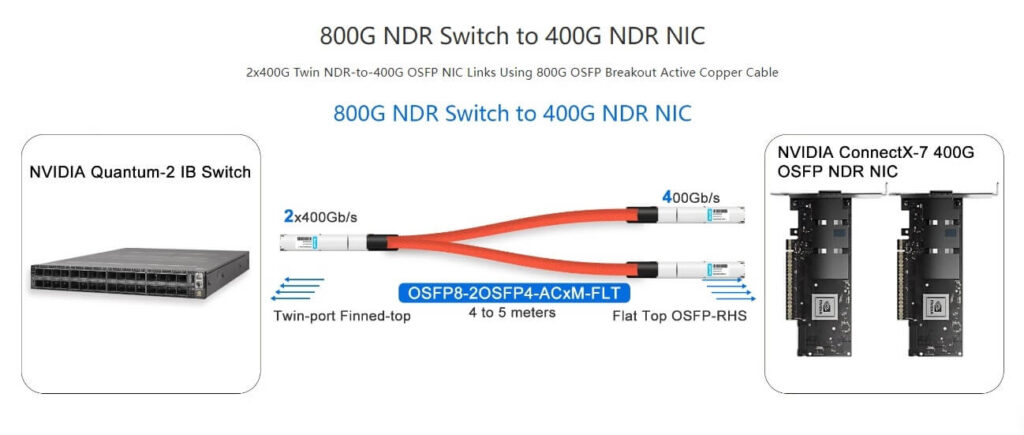
Storage Network Optimization
IB Twin-Port Design: Delivers 400Gb/s full-duplex with <600ns latency for distributed metadata synchronization.
QSFP56 Compatibility: Enables legacy device integration via OSFP-to-QSFP adapters.
HPC Interconnect Solutions
Fat-Tree Topology: AEC-based CLOS networks support 32 MPI processes per link.
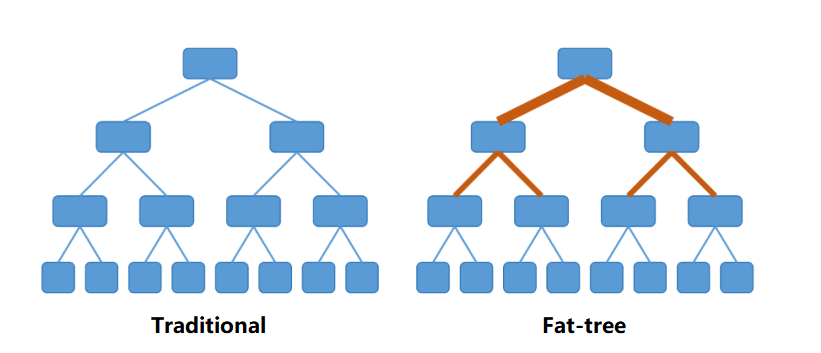
Liquid Cooling Readiness: Gold-plated contacts validated for immersion cooling (IEC 60512-99-001).
Technology Comparison & Selection Guide
Product Feature Matrix
| Feature | DAC | ACC | AEC |
| Max Distance | ≤3m | ≤7m | ≤10m |
| Power Consumption | 0.5-0.8W | 1.2-1.8W | 2.5-3.5W |
| Cost Multiplier | 1x | 1.8x | 3x |
| Ideal Use Case | Intra-rack | Cross-rack | HPC/ML |
Decision Workflow
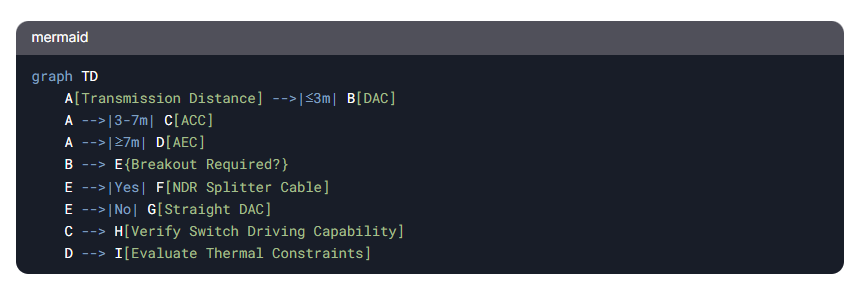
Future Roadmap
Co-Packaged Optics: Intel-Ayar Labs collaboration integrates Retimer into switch ASICs, reducing power by 30%.
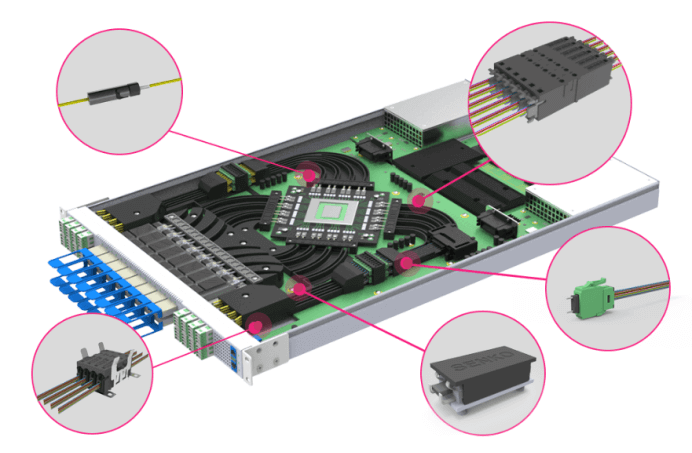
Smart Diagnostics: BMC-enabled I2C monitoring with real-time BER analysis (CMIS 5.0 compliant).
Material Innovation: Carbon nanotube composite conductors projected to extend 800G DAC reach to 5m.
Conclusion
In the age of compute-driven digital transformation, 400GB NDR splitter cables and OSFP copper technologies are redefining data center economics. From cost-optimized DACs to performance-centric AECs, this ecosystem demonstrates remarkable progress in signal integrity engineering while balancing TCO and bandwidth demands. As OAM (Open Accelerator Module) standards evolve, these solutions will continue empowering AI clusters, 5G core networks, and next-gen HPC architectures.
Related Products:
-
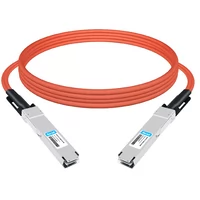 OSFP-FLT-800G-AC3M 3m (10ft) 800G Twin-port 2x400G OSFP to 2x400G OSFP InfiniBand NDR Active Copper Cable, Flat top on one end and Flat top on the other
$600.00
OSFP-FLT-800G-AC3M 3m (10ft) 800G Twin-port 2x400G OSFP to 2x400G OSFP InfiniBand NDR Active Copper Cable, Flat top on one end and Flat top on the other
$600.00
-
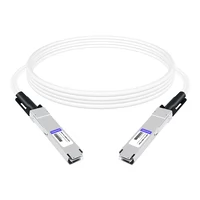 OSFP-FLT-800G-PC2M 2m (7ft) 2x400G OSFP to 2x400G OSFP PAM4 InfiniBand NDR Passive Direct Attached Cable, Flat top on one end and Flat top on the other
$300.00
OSFP-FLT-800G-PC2M 2m (7ft) 2x400G OSFP to 2x400G OSFP PAM4 InfiniBand NDR Passive Direct Attached Cable, Flat top on one end and Flat top on the other
$300.00
-
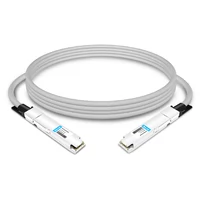 OSFP-800G-PC50CM 0.5m (1.6ft) 800G Twin-port 2x400G OSFP to 2x400G OSFP InfiniBand NDR Passive Direct Attach Copper Cable
$105.00
OSFP-800G-PC50CM 0.5m (1.6ft) 800G Twin-port 2x400G OSFP to 2x400G OSFP InfiniBand NDR Passive Direct Attach Copper Cable
$105.00
-
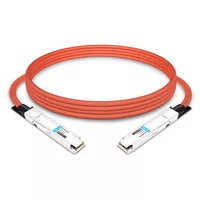 OSFP-800G-AC3M 3m (10ft) 800G Twin-port 2x400G OSFP to 2x400G OSFP InfiniBand NDR Active Copper Cable
$600.00
OSFP-800G-AC3M 3m (10ft) 800G Twin-port 2x400G OSFP to 2x400G OSFP InfiniBand NDR Active Copper Cable
$600.00
-
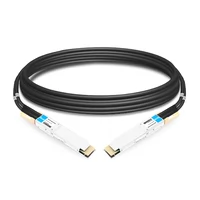 QSFPDD-800G-PC50CM 0.5m (1.6ft) 800G QSFP-DD to QSFP-DD QSFP-DD800 PAM4 Passive Direct Attach Cable
$145.00
QSFPDD-800G-PC50CM 0.5m (1.6ft) 800G QSFP-DD to QSFP-DD QSFP-DD800 PAM4 Passive Direct Attach Cable
$145.00
-
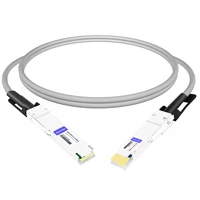 QDD-OSFP-FLT-PC50CM 0.5m (1.6ft) 400G QSFP-DD to OSFP Flat Top PAM4 Passive Direct Attached Cable
$154.00
QDD-OSFP-FLT-PC50CM 0.5m (1.6ft) 400G QSFP-DD to OSFP Flat Top PAM4 Passive Direct Attached Cable
$154.00
-
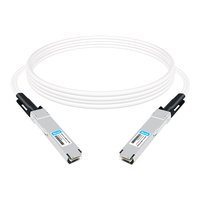 OSFP-FLT-400G-PC50CM 0.5m (1.6ft) 400G NDR OSFP to OSFP PAM4 Passive Direct Attached Cable, Flat top on one end and Flat top on other
$110.00
OSFP-FLT-400G-PC50CM 0.5m (1.6ft) 400G NDR OSFP to OSFP PAM4 Passive Direct Attached Cable, Flat top on one end and Flat top on other
$110.00
-
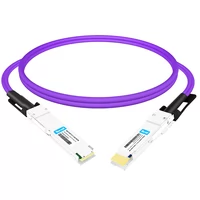 QDD-OSFP-FLT-AEC50CM 0.5m (1.6ft) 400G QSFP-DD to OSFP Flat Top PAM4 Active Electrical Copper Cable
$1200.00
QDD-OSFP-FLT-AEC50CM 0.5m (1.6ft) 400G QSFP-DD to OSFP Flat Top PAM4 Active Electrical Copper Cable
$1200.00
-
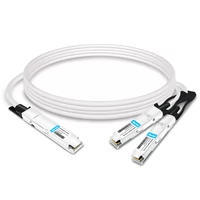 NVIDIA MCP7Y10-N001 Compatible 1m (3ft) 800G InfiniBand NDR Twin-port OSFP to 2x400G QSFP112 Breakout DAC
$165.00
NVIDIA MCP7Y10-N001 Compatible 1m (3ft) 800G InfiniBand NDR Twin-port OSFP to 2x400G QSFP112 Breakout DAC
$165.00
-
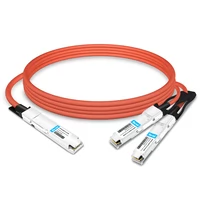 NVIDIA MCA7J65-N004 Compatible 4m (13ft) 800G Twin-port OSFP to 2x400G QSFP112 InfiniBand NDR Breakout Active Copper Cable
$800.00
NVIDIA MCA7J65-N004 Compatible 4m (13ft) 800G Twin-port OSFP to 2x400G QSFP112 InfiniBand NDR Breakout Active Copper Cable
$800.00
-
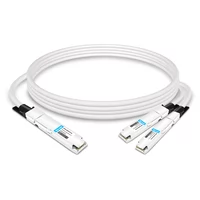 NVIDIA MCP7Y00-N001 Compatible 1m (3ft) 800Gb Twin-port OSFP to 2x400G OSFP InfiniBand NDR Breakout Direct Attach Copper Cable
$175.00
NVIDIA MCP7Y00-N001 Compatible 1m (3ft) 800Gb Twin-port OSFP to 2x400G OSFP InfiniBand NDR Breakout Direct Attach Copper Cable
$175.00
-
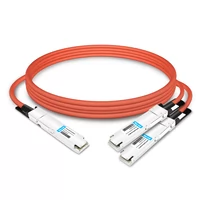 NVIDIA MCA7J60-N004 Compatible 4m (13ft) 800G Twin-port OSFP to 2x400G OSFP InfiniBand NDR Breakout Active Copper Cable
$800.00
NVIDIA MCA7J60-N004 Compatible 4m (13ft) 800G Twin-port OSFP to 2x400G OSFP InfiniBand NDR Breakout Active Copper Cable
$800.00
